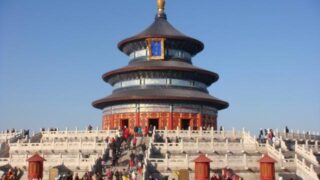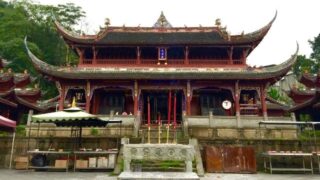In contemporary China, some try to establish a “Confucian Church,” while Xi Jinping believes a non-religious Confucianism lives within the Communist Party.
by Massimo Introvigne
Article 5 of 5. Read article 1, article 2, article 3, and article 4.


On February 12, 1912, the child emperor Puyi (1906–1967) abdicated, putting an end to the millennia-old Chinese Empire. Many, including Western scholars, believed this was the end of Confucianism as well. Confucianism had a doctrine and rites, but no independent organization. Its organization was the Imperial Chinese state. Without the Empire, Confucianism lost its body and was reduced to a wandering ghost, a metaphor several scholars have used.
But it was not exactly so. Popular Confucianism, where Confucius was worshipped and prayed for healing or good fortune in a myriad of temples, existed quite independently of the Imperial bureaucracy, and survived. So did the new religious movements that included or had incorporated Confucian elements, including the large and successful Yiguandao. And there was more. Seeing the writing on the wall, an intellectual called Kang Youwei (1858–1927) in 1898 had proposed to save both the Empire and Confucianism by establishing a constitutional monarchy, and a state “Confucian Church” that would be to China what the Church of England was to the British Empire.
Both his proposals ultimately failed, but his disciple Chen Huanzhang (1881–1933) formally established a Confucian Church in 1912. Several personalities of the Chinese Republic followed the experiment with interest, seriously considering the idea of establishing Confucianism as China’s state religion.


From the subsequent decade on, however, the main ideologists of the Republic were inspired by the European Enlightenment, and believed Confucianism was a backward influence to be marginalized. They also tried to suppress new religious movements and several aspects of folk religion they denounced as superstition, but the effectiveness of their campaigns was limited.
Communist China was an entirely different matter. In the 1950s, Chairman Mao (1893–1976) launched a massive persecution of new religious movements, which particularly targeted Yiguandao. More than ten million Yiguandao devotees ended up in jail, and thousands were killed.
Folk religion was initially left alone, but the Cultural Revolution (1966–1976) destroyed most of Confucius’ temples. It also conducted public trials where Confucius himself was denounced as the epitome of counter-revolutionary superstition, and later as the alleged inspirer of the disgraced Communist leader Lin Biao (1907–1971). In Qufu, the birthplace of Confucius, the sage’s statue was destroyed, and the cemetery of his family desecrated.
![“Wage the Struggle of Criticizing Lin [Biao] and Confucius to the End!” Cultural Revolution poster, 1974. Source: Chineseposters.net.](https://bitterwinter.org/wp-content/uploads/2022/05/Cultural-Revolution-poster.jpeg)
![“Wage the Struggle of Criticizing Lin [Biao] and Confucius to the End!” Cultural Revolution poster, 1974. Source: Chineseposters.net.](https://bitterwinter.org/wp-content/uploads/2022/05/Cultural-Revolution-poster.jpeg)
Once again, many commented this was the end of Confucianism, whose vestiges can perhaps survive in Taiwan, Hong Kong, and the Chinese diaspora only. Once again, it wasn’t. Yes, it was outside Mainland China that a vigorous philosophical movement to revive Confucianism as a “New Ru Learning” had developed around Mou Zongsan (1909–1995), a Shandong-born thinker who had moved to Taiwan in 1949 and from there to Hong Kong in 1960.
Mou was a main force behind the “Manifesto on Chinese Culture” of 1958, which indicated that restoring the Way of the Ru was essential for promoting a democracy with Chinese characteristics. Although originally few noticed the Manifesto outside the Taiwanese academic milieu, in retrospect it has been considered a milestone towards a new spring for philosophical Confucianism that somewhat managed to spread to the Mainland as well.
This was not good enough for several academics and businesspersons who emerged as advocates for Confucianism in Mainland China after the end of the Cultural Revolution and Mao’s death in 1976. What they asked for Confucianism was official recognition as a religion, and acknowledgement that it was indeed the most Chinese of all religions.
Mao tried to control religion in China through the five authorized religions, whose leaders were appointed by the Communist Party. These were Buddhism, Taoism, Islam, Protestantism, and Catholicism. The Cultural Revolution destroyed the five official organizations, and Deng Xiaoping (1904–1997) resurrected them, but through all these developments the religions thus acknowledged remained five. Confucianism was not one of them, although some have argued that it was, and remains, the sixth recognized religion in Hong Kong.
There were different reasons for this: Mao’s antipathy for Confucianism, the CCP ideologists’ idea that it was not a religion, and—perhaps more importantly—the fact that the whole project was aimed at controlling organized religion, and post-imperial Confucianism was not really organized.
In 2014, Sébastien Billioud and Joël Thoraval published a fascinating book, “Le Sage et le peuple. Le renouveau confucéen en Chine” (Paris: CNRS Éditions; English translation, “The Sage and the People: The Confucian Revival in China,” New York: Oxford University Press, 2015). One part of the book details the quest for official recognition of Confucianism as a religion in China, an enterprise involving tenured academics and wealthy businesspersons, who built new temples and “academies” in the old Ru style. They have founded a Holy Confucian Church (孔圣会, Kongshenghui) in 2015, although they cautiously registered it as a cultural NGO rather than as a religious organization.


There are three points to be noted about this movement. First, it obviously believes that Confucianism is a religion. Perhaps, as we mentioned in this series, it was a religious tradition rather than a religion for millennia. In the mind of these activists, it is now becoming a full-fledged religion. Second, although a subject of great fascination for Western scholars, the movement has not become a main player in the Chinese religious and political arena.
Third, so far nobody has been arrested, and the organizations the Confucian activists have founded have not been declared illegal. As all observers of Chinese religion know, the latter is a circumstance that can change overnight. But so far so good for Confucius and his followers.
Why it is so is an interesting question. Chen Yong, the author of “Confucianism as Religion: Controversies and Consequences” (Leiden: Brill, 2013), has told the story of how an “official Confucianism” had a prehistory under Hu Jintao and became an important part of the CCP ideology under Xi Jinping. “Not until 2012, writes Chen, when Xi Jinping took office, did the Communist Party start to systematically and consistently integrate a Confucian persuasion into its established ideology” (“‘Official Confucianism’ as Newly Sanctioned by the Chinese Communist Party,” in “The Sinicization of Chinese Religion: From Above and Below,” edited by Richard Madsen, Leiden: Brill, 2021, p. 44–63 [45]).
But what is exactly a “Confucian persuasion”? In 2013, Xi Jinping was the first leader of the People’s Republic of China who paid an official visit to Confucius’ birthplace in Qufu, which had been restored after the Cultural Revolution.
He is not shy when it comes to quote in his speeches the Five Classics and the Confucian canon, as if to style himself as a modern Ru. He has sent the CCP top cadres to attend mandatory courses on the Classics and Confucius. He has even authorized the leaders of provincial governments to attend rituals honoring Confucius in Qufu and elsewhere, although Billioud and Thoraval have noted that they sometimes look like pop events, where even popular singers perform, rather than as religious rites.


Several Western scholars have noted the prevalence of Confucian terminology in Xi’s CCP, and have emphasized the importance of a 2017 CCP document, “On Implementing the Project of Preserving and Developing the Excellent Chinese Traditional Culture.” Is Confucius back, and is he this time waving a red flag?
Again, it is easy to misunderstand what is going on. The 2017 CCP document never mentions Confucius, Confucianism, or Ru. They are there, of course, but implicitly only. Confucius temples are being restored, but the process some have called “museification” also continues. They fare much better if they serve as museums than if they try to be real places of worship.
Chen Yong’s analysis of Xi Jinping’s approach to Confucianism notes that it is based on the idea that the CCP is the legitimate heir of the Ru. This is why Xi does not take those who want to reorganize Confucianism as a religion very seriously. Confucianism had once a body, the Chinese Empire. Today, it does not need a new body in the shape of a “church” because it has already found one. This body is the Chinese Communist Party.
Make no mistake, the fact that the CCP embodies the “excellent Chinese traditional culture,” which includes the Way of the Ru and Confucianism, does not make the Party any less Marxist. The 2022 campaign for the promotion of atheism, which argues that Confucius was the first great atheist philosopher in the world, is important as it allows to include Confucius and Marx in the same CCP pantheon.
Actually, Xi Jinping’s claims are even more grandiose. I have noted elsewhere that to understand Xi Jinping Marx is not enough, and one should consider his debt to Georg Wilhelm Friedrich Hegel (1770–1831). Xi’s may be a simplified Hegel, but in how the Chinese President sees history the Hegelian scheme of thesis-antithesis-synthesis is never far away (I don’t believe Xi is interested in contemporary Western scholarly discussions on whether Hegel really taught the tripartite model).
The official history of the CCP, consecrated in 2021 in the Third Resolution on the History of the Party, teaches that in the history of the People’s Republic Mao was the thesis, Deng Xiaoping was the antithesis who reacted against certain excesses of Mao, and Xi Jinping serves as the synthesis who incorporated the best of Mao and Deng, yet according to a dialectic version of history could only come after them.
Simultaneously, however, a broader dialectic model sees the “excellent Chinese traditional culture” as the thesis, Marxism as the antithesis, and Xi Jinping’s thought as the synthesis. The “excellent Chinese traditional culture” —by which Xi means the Classics and the Confucian tradition (with the addition of certain other elements)—is only valuable if it is subsumed in this dialectic scheme.
Since not everything is amenable to dialectic, Xi should subtract from Confucianism all the religious elements, and leave free rein to those presenting Confucius as the father of atheism. The latter are as incorrect as those who make Confucius the founder of a “church.”
Confucianism is indeed a religious tradition—neither a religion nor a school of atheism—, something that would not suit either Xi Jinping or the Holy Confucian Church. While the latter is a curiosity, Xi Jinping’s falsification of the Chinese culture is much more dangerous, and needs to be exposed.









